Ranunculus Asiaticus: Care Guide for Flower
Ranunculus Asiaticus, commonly known as Persian buttercup, is a favorite among gardeners and florists due to its vibrant, rose-like blooms and delicate, multi-layered petals. These stunning flowers come in a variety of colors, including red, pink, yellow, orange, and white, making them a versatile choice for both gardens and floral arrangements. Their elegant appearance and long vase life make them highly sought after for weddings and bouquets. Ranunculus thrives in cool weather and is best planted in the fall for early spring blooms. With proper care, these flowers can produce abundant blossoms that add a touch of sophistication to any landscape. They require well-draining soil, plenty of sunlight, and regular watering to flourish. Whether grown in flower beds, containers, or cut flower gardens, Ranunculus Asiaticus is a rewarding plant that brings beauty and charm to any setting. Our gardening blog is a perfect place to find all the information you need!
Why Choose Ranunculus Asiaticus for Your Garden or Home?
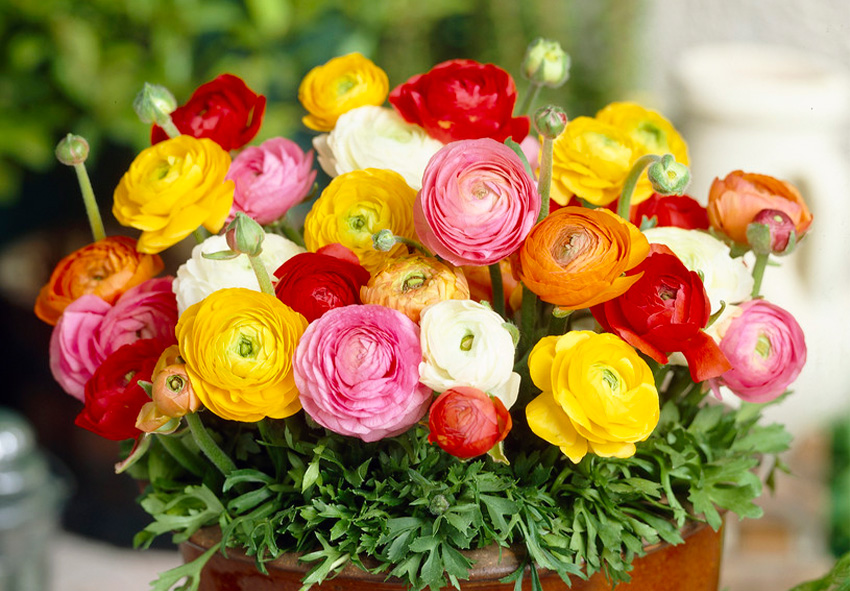
Ranunculus Asiaticus (Persian buttercup) is an excellent choice for both garden landscapes and home floral displays due to its striking, layered petals and impressive range of colors. These flowers bloom in shades of red, pink, orange, yellow, and white, providing an elegant and romantic aesthetic wherever they are planted. One of the biggest advantages of Ranunculus is its long vase life, often lasting up to two weeks when cut and placed in water, making them perfect for floral arrangements and event decorations.
In addition to their beauty, Ranunculus flowers thrive in cool temperatures, making them ideal for early spring gardens. They perform best when planted in the fall in mild climates or started indoors and transplanted outdoors in colder regions. These plants prefer full sun, well-draining soil, and consistent moisture, which helps them produce multiple blooms per plant. Gardeners also love Ranunculus for their compact size, making them great for garden borders, flower beds, or patio containers. With proper care, these flowers will reward you with stunning, vibrant blooms season after season. Whether you are looking to brighten up your garden or create stunning floral arrangements, Ranunculus Asiaticus (Persian buttercup) is a perfect choice for its beauty, versatility, and ease of care.
The Most Popular Ranunculus Asiaticus Varieties and Their Characteristics
Ranunculus Asiaticus (Persian buttercup) offers a stunning selection of varieties, each with unique characteristics that make them stand out in gardens and floral arrangements. Some varieties feature large, densely layered petals that resemble roses, while others display softer, more delicate blooms. Among the most popular types, the ‘Cloni’ series is highly valued for its oversized, long-lasting flowers, making it a top choice for cut flower enthusiasts.
For gardeners seeking a vibrant, eye-catching display, the ‘Tecolote’ series is a favorite, producing large, full blooms in a wide range of colors, including deep reds, bright oranges, and soft pastels. These flowers grow well in garden beds and containers, providing a striking burst of color in the spring. Another well-loved variety is ‘Bloomingdale,’ which features compact, uniform flowers that are perfect for smaller spaces or container gardening.
Ranunculus also includes bi-colored and picotee varieties, adding even more diversity to their stunning palette. These blooms make exceptional additions to bouquets and floral designs, thanks to their rich colors and long vase life. Whether you prefer bold, dramatic hues or soft, romantic tones, there is a Ranunculus Asiaticus (Persian buttercup) variety to suit every gardener’s taste and aesthetic preference.
Classic White and Cream Ranunculus
For an elegant and timeless garden, white and cream Ranunculus varieties offer a soft, sophisticated look. These blooms pair beautifully with any floral arrangement and create a serene, refined atmosphere in flower beds or bouquets.
- ‘Aviv White’ – A classic white Ranunculus with large, full petals and a delicate, ruffled texture.
- ‘Buttercream’ – A soft, creamy variety that adds warmth and depth to arrangements.
- ‘Cloni White’ – Known for its oversized blooms and long vase life, perfect for weddings and events.
- ‘Tecolote White’ – A sturdy, reliable variety with bright white petals and a full, rounded shape.
- ‘Porcelaine’ – A delicate, off-white variety with hints of blush, giving it a subtle, romantic appeal.
These varieties thrive in well-draining soil and full sun, producing stunning blooms that elevate any garden or floral display.
Bright and Vibrant Ranunculus for Bold Gardens
For those who love eye-catching flowers, bright and bold Ranunculus varieties bring energy and excitement to any garden. Their intense hues stand out in flower beds and make dazzling additions to floral arrangements.
- ‘Aviv Red’ – A striking variety with bright red petals edged in white for a dramatic effect.
- ‘Tango Orange’ – A fiery orange Ranunculus that adds warmth and vibrancy to any space.
- ‘Tecolote Gold’ – A bright golden-yellow bloom that radiates sunshine and cheerfulness.
- ‘Mistral Red’ – A deep, bold red Ranunculus with velvety petals and strong stems.
- ‘Amandine Purple’ – A rich, purple-toned variety that creates a regal garden display.
These bold blooms thrive in full sun and well-drained soil, making them ideal for gardeners looking to add a pop of color.
Soft Pastel Ranunculus for a Romantic Look
For a dreamy and romantic garden, pastel Ranunculus varieties offer delicate shades that exude elegance and charm. These soft-toned flowers blend beautifully with other spring blooms, creating a graceful floral display.
- ‘Aviv Pink’ – A highly sought-after variety with soft, blush-pink petals and a rose-like form.
- ‘Champagne’ – A light peach variety with a warm, glowing hue, perfect for elegant arrangements.
- ‘Amandine Rose’ – A soft, classic pink Ranunculus that adds a delicate touch to gardens and bouquets.
- ‘Mistral Lilac’ – A stunning lavender variety with subtle purple undertones.
- ‘Pastel Mix’ – A collection of pale pink, peach, and creamy white blooms for a soft, romantic feel.
These varieties thrive in cool temperatures and are ideal for wedding bouquets, garden borders, and container plantings.
Exotic and Bi-Colored Ranunculus
For a unique and eye-catching garden, bi-colored Ranunculus varieties add intrigue and contrast with their striking petal patterns. These rare blooms are perfect for floral enthusiasts who want something extraordinary.
- ‘Dark Pink’ – A stunning dark-toned Ranunculus with deep violet and black petals.
- ‘Pastel Mix’ – A collection of bi-colored blooms in soft pastel shades.
- ‘Picotee Mix’ – A striking selection featuring flowers edged in a darker hue for added dimension.
- ‘Tecolote Striped’ – A rare variety with striped petals in shades of pink, red, and white.
- ‘Amandine Bicolor Rose’ – A gorgeous blend of pink and cream with a soft, gradient effect.
These exotic Ranunculus varieties bring flair and elegance to gardens and floral arrangements, offering a one-of-a-kind visual impact.
How to Plant and Grow Ranunculus Asiaticus Successfully
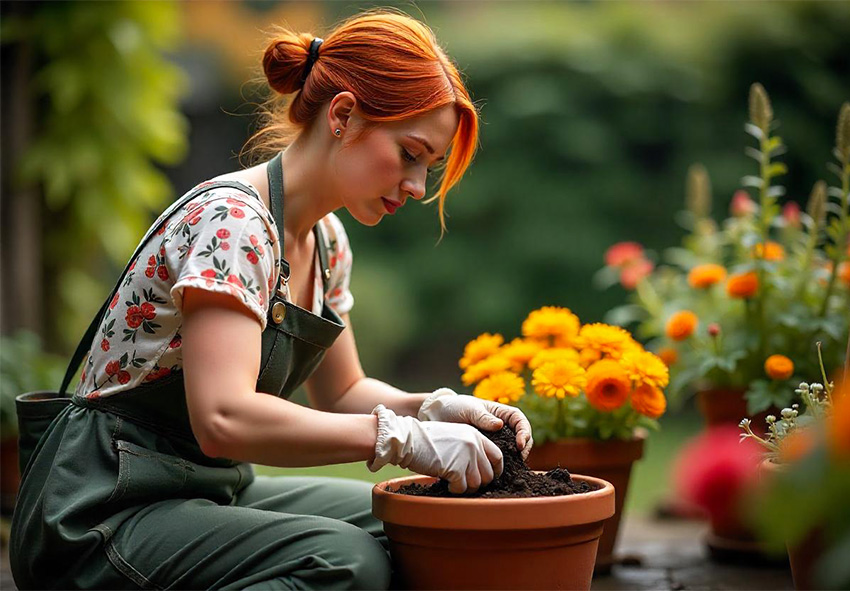
Ranunculus Asiaticus, known for its stunning, rose-like blooms, thrives when given the right conditions. These flowers are a favorite among gardeners and florists due to their vibrant colors and long-lasting nature. To ensure successful growth, it’s essential to start with high-quality tubers, plant them in suitable soil, and provide proper care throughout the growing season. Ranunculus performs best in cool temperatures and well-draining soil, making early spring or fall the ideal planting time, depending on the climate. By following a step-by-step approach, you can enjoy a spectacular display of delicate, multi-petaled blooms in your garden or containers.
From selecting firm, healthy tubers to planting them at the right depth, each stage plays a vital role in their development. Proper watering, spacing, and pre-sprouting techniques also enhance their chances of producing strong, healthy plants. With a bit of preparation and care, Ranunculus can reward you with a dazzling floral show that lasts for weeks. Whether grown in garden beds or containers, these flowers add elegance and charm to any space. Learning the essential steps of planting and caring for Ranunculus ensures that they thrive and continue to bloom beautifully throughout the season.
Step-by-Step Guide to Planting Ranunculus Asiaticus (Persian buttercup)
Planting Ranunculus Asiaticus (Persian buttercup) successfully requires careful preparation and attention to detail. Selecting healthy tubers, choosing the right location, and ensuring proper planting depth are crucial for their growth. Additionally, soaking and pre-sprouting can improve germination rates. By following a structured planting process, you can enjoy vibrant and long-lasting blooms in your garden.
Step 1: Choosing Quality Ranunculus Tubers
Selecting high-quality Ranunculus tubers is the first step to ensuring healthy growth and abundant blooms. The best tubers are large, firm, and have a claw-like appearance, which indicates their viability. Avoid tubers that appear shriveled, soft, or moldy, as these may struggle to sprout and develop strong roots. Size is also an important factor; larger tubers tend to produce more robust plants with multiple blooms.
Purchasing tubers from a reputable supplier ensures that they are disease-free and ready for planting. If possible, choose fresh tubers rather than older, dried-out ones, as fresher tubers have a higher success rate. Proper storage before planting is also important—keep them in a cool, dry place until ready for use. By selecting the best tubers and handling them with care, you increase the chances of strong, healthy plants that will reward you with beautiful, long-lasting flowers.
Step 2: Choosing the Right Soil and Location
Ranunculus thrives in well-draining, fertile soil with a slightly acidic to neutral pH, ideally between 6.0 and 6.5. Loamy soil rich in organic matter is ideal, as it retains moisture while preventing waterlogging. If your soil is heavy clay, amending it with compost or sand can improve drainage and aeration. Poorly draining soil can cause tubers to rot before they even sprout, so ensuring the right soil conditions is crucial.
Selecting the right location is equally important. Ranunculus flourishes in full sun, requiring at least six hours of direct sunlight per day. A sunny spot with good air circulation helps prevent fungal diseases and encourages strong, healthy blooms. In warmer climates, partial shade during the hottest part of the day can prevent stress on the plants. By providing the right soil conditions and a well-lit location, you set the foundation for a thriving and productive Ranunculus display.
Step 3: Soaking and Pre-Sprouting Ranunculus Tubers
Soaking Ranunculus tubers before planting helps rehydrate them and speeds up germination. To prepare them, place the tubers in a bowl of room-temperature water for three to four hours. This process allows them to absorb moisture, plump up, and prepare for active growth. However, be careful not to soak them for too long, as excessive moisture can lead to rot.
Pre-sprouting is another useful technique, especially for gardeners in colder climates or those who want an early start. After soaking, place the tubers in a tray filled with slightly damp potting mix and store them in a cool environment (around 50-55°F or 10-12°C). Within a couple of weeks, small rootlets and shoots will begin to emerge, indicating that they are ready for planting. This method gives the tubers a head start, leading to quicker establishment and earlier blooming once transplanted into the garden.
Step 4: Proper Planting Depth and Spacing
When planting Ranunculus tubers, depth and spacing are key to healthy growth and optimal flowering. Tubers should be planted 1 to 2 inches deep with their claw-like structures facing downward. This positioning allows the roots to anchor properly and the shoots to emerge effortlessly. If planted too deep, the tubers may struggle to sprout; if too shallow, they risk drying out or becoming unstable.
Spacing is equally important for ensuring good airflow and preventing disease. Each tuber should be placed 4 to 6 inches apart to allow for adequate room to grow. In garden beds, stagger the planting pattern for a fuller display, while in containers, ensure they aren’t overcrowded. Proper spacing helps reduce the risk of fungal infections and allows each plant to receive enough nutrients and sunlight. With the right planting depth and spacing, Ranunculus will grow strong, producing lush foliage and vibrant blooms.
Step 5: Watering After Planting
Watering plays a critical role in the successful establishment of Ranunculus tubers. After planting, water lightly to help settle the soil around the tubers, but avoid excessive moisture. Overwatering at this stage can lead to rot before the tubers have a chance to sprout. Keep the soil slightly moist but never soggy.
Once the first shoots appear, gradually increase watering to keep the soil evenly moist. Ranunculus prefers consistent moisture, especially during active growth and blooming periods. However, standing water can cause root rot, so always ensure that the soil drains well between waterings. During dry spells, deep watering once or twice a week is beneficial, while in rainy conditions, additional watering may not be necessary. Proper watering habits ensure strong root development, leading to healthy plants and an abundance of long-lasting flowers throughout the season.
Essential Ranunculus Asiaticus Care Tips for Healthy Growth
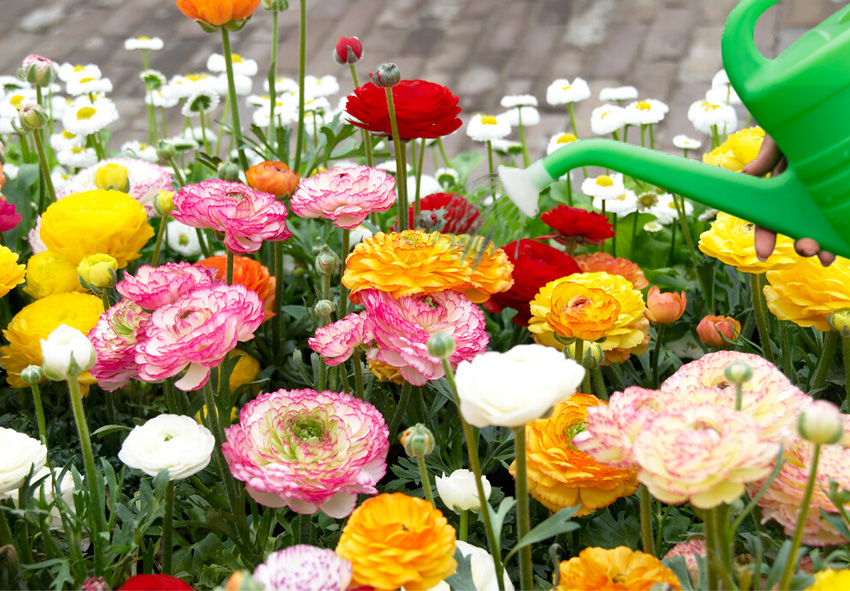
Ranunculus Asiaticus (Persian buttercup) is a stunning, long-lasting flower that requires specific care to ensure healthy growth and abundant blooms. Providing the right balance of water, light, temperature, and nutrients is key to keeping these plants thriving. Ranunculus prefers cool temperatures and moist, well-drained soil. Overwatering or exposure to extreme heat can lead to poor growth, so monitoring environmental conditions is essential.
Proper watering techniques help maintain soil moisture without causing fungal infections. Fertilizing regularly ensures strong stems and vibrant flowers, while avoiding excess feeding once the buds begin to open prevents weak growth. Light and temperature management also play a role in bloom longevity, with cooler conditions supporting prolonged flowering. Additionally, taller Ranunculus varieties may require staking to prevent bending under the weight of their delicate, multi-petaled blooms.
By following essential ranunculus bulb care practices, Ranunculus can flourish, rewarding gardeners with breathtaking floral displays that last throughout the growing season.
How to Care for Ranunculus Asiaticus (Persian buttercup) After Planting
It’s important to know how to care for ranunculus asiaticus in the garden just as to learn how to care for ranunculus asiaticus indoors. After planting, Ranunculus requires careful maintenance to ensure strong growth and beautiful blooms. Proper watering, fertilization, and temperature control are crucial for keeping the plants healthy. Supporting taller varieties can also help prevent bending. With the right care, Ranunculus will continue to produce vibrant flowers throughout the blooming season.
Step 1: Watering Ranunculus Asiaticus (Persian buttercup) the Right Way
Watering plays a crucial role in Ranunculus Asiaticus’ overall health and blooming success. These plants prefer consistent moisture but are highly susceptible to rot if overwatered. Deep watering once a week in dry conditions helps keep the roots hydrated without waterlogging the soil. If rainfall is sufficient, additional watering may not be necessary.
To prevent fungal infections, it’s best to water at the base of the plant rather than overhead. Wet foliage can lead to mold and mildew, which weakens the plant and reduces flowering potential. Using a drip irrigation system or watering early in the morning allows excess moisture to evaporate before nightfall.
As the plant matures, maintaining consistent soil moisture without letting it become soggy will encourage strong root development and an extended blooming period. Proper watering habits ensure that Ranunculus remains healthy and produces abundant, vibrant blooms.
Step 2: Fertilizing for Strong Growth
Feeding Ranunculus Asiaticus (Persian buttercup) with the right nutrients supports vigorous growth and enhances flower production. A balanced fertilizer with an equal ratio, such as 10-10-10, provides essential nitrogen, phosphorus, and potassium for overall plant health. Applying fertilizer every two weeks during the growing season ensures that the plants receive a steady supply of nutrients.
Too much nitrogen can encourage excessive foliage growth at the expense of blooms, so it’s important to use a balanced formula. As the buds begin to open, reduce or stop fertilizing to prevent overstimulation, which can lead to weaker stems and shorter bloom periods.
In addition to commercial fertilizers, incorporating organic matter like compost or well-rotted manure into the soil can provide long-term nourishment. Proper feeding helps maintain strong stems, lush foliage, and large, vibrant flowers, ensuring that Ranunculus thrives throughout the season.
Step 3: Providing Proper Light and Temperature
Ranunculus Asiaticus (Persian buttercup) flourishes in bright, full sunlight and cool temperatures, making spring and early summer the ideal growing periods. These flowers prefer temperatures ranging from 10-18°C (50-65°F), which allows them to develop strong stems and prolonged blooms. If temperatures rise above 21°C (70°F), Ranunculus may begin to fade more quickly.
Providing light shade during the hottest parts of the day can help protect the flowers from heat stress, especially in warmer climates. Good air circulation around the plants also prevents diseases that thrive in humid conditions.
If grown indoors or in greenhouses, ensuring adequate ventilation and light exposure is crucial for healthy development. Sudden temperature fluctuations or excessive warmth can lead to weak, leggy growth. By maintaining optimal light and temperature conditions, gardeners can enjoy long-lasting, vibrant blooms throughout the Ranunculus growing season.
Step 4: Supporting Ranunculus Stems
Ranunculus stems, while strong enough to support their delicate blooms, can sometimes bend or droop under the weight of the flowers. Providing proper support ensures that the blooms remain upright and healthy throughout the growing season. Taller varieties may require small stakes or plant supports, especially in windy areas.
Pinching back weaker stems encourages the plant to focus its energy on producing stronger growth. Removing side shoots can also lead to larger, more robust blooms. If stems become too tall and thin due to lack of light, adjusting their growing conditions can help strengthen their structure.
For potted Ranunculus, placing them in a sheltered yet bright location helps prevent excessive stretching or bending. By taking the necessary precautions to support their stems, Ranunculus plants will continue producing vibrant, long-lasting flowers with sturdy, upright growth.
How to Encourage Your Ranunculus Asiaticus to Bloom Again
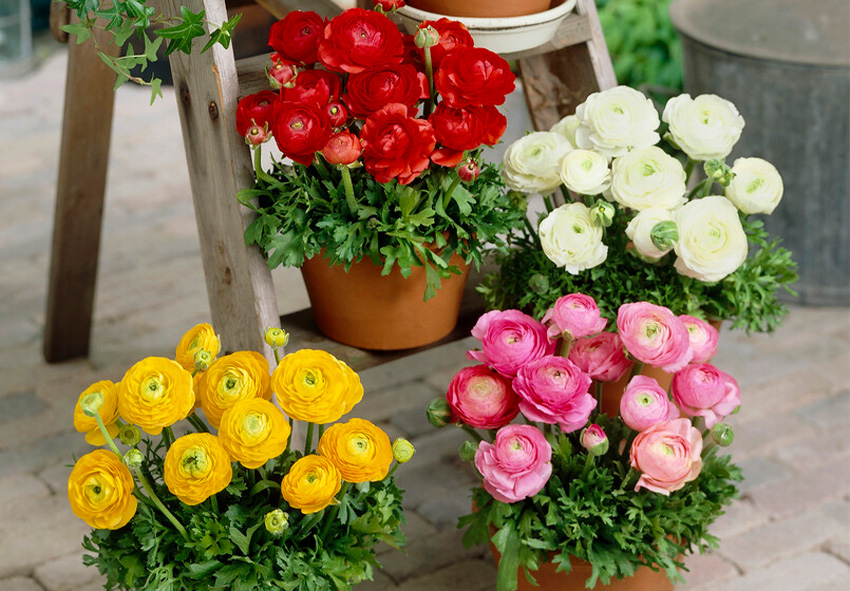
Ranunculus Asiaticus (Persian buttercup) is known for its lush, layered blooms, but ensuring a second flowering period can be challenging. While these plants produce stunning flowers in their first season, they may not rebloom unless properly cared for. Factors such as environmental conditions, post-bloom maintenance, and tuber health all play a role in future flowering success.
To promote continuous blooming, deadheading spent flowers prevents energy loss and encourages new bud formation. Once the flowering cycle ends, proper preparation for dormancy is crucial. As the foliage naturally yellows and dies back, reducing watering allows the tubers to store energy for the next season. Storing them correctly during dormancy also ensures their viability for replanting.
Dividing and replanting tubers every few years helps maintain healthy, vigorous plants. With the right care, Ranunculus Asiaticus (Persian buttercup) can rebloom, offering beautiful flowers year after year, both in gardens and floral arrangements.
Step-by-Step Guide to Ensuring Reblooming
Encouraging Ranunculus Asiaticus (Persian buttercup) to rebloom requires proper care during and after its flowering period. Regular deadheading keeps the plant producing flowers, while preparing it for dormancy helps sustain healthy tubers. Dividing and transplanting tubers every few seasons rejuvenates growth, ensuring that Ranunculus continues to thrive and bloom in future growing seasons.
Step 1: Deadheading and Post-Bloom Care
Deadheading is a key step in encouraging Ranunculus Asiaticus (Persian buttercup) to rebloom. By removing spent flowers, the plant redirects energy into producing new buds rather than seed formation. To do this, cut back faded blooms to the nearest healthy leaf node, using sharp, sterilized scissors to prevent disease spread.
After the flowering season, allow the foliage to remain intact. The leaves continue photosynthesis, which helps the tubers store energy for future blooms. Prematurely cutting back the leaves can weaken the plant and reduce flowering potential in the next season.
If grown in containers, moving the plants to a cooler, shaded area after blooming can extend their lifespan. With proper deadheading and post-bloom care, Ranunculus can produce a second flush of flowers in some climates, or at the very least, store ample energy for a successful growing season the following year.
Step 2: Preparing Ranunculus for Dormancy
Once Ranunculus Asiaticus (Persian buttercup) has finished blooming, preparing the plant for dormancy is essential to ensure healthy regrowth in the next season. As the plant naturally begins to die back, stop watering to prevent tubers from rotting. Allow the foliage to turn yellow and dry up completely before cutting it back.
In colder climates, tubers should be lifted from the ground before winter frost sets in. Carefully dig them up, shake off excess soil, and allow them to dry in a well-ventilated area for a few days. Store them in a cool, dry place, such as a paper bag filled with dry peat moss or sawdust, to protect them from moisture and rot.
For regions with mild winters, Ranunculus may overwinter in the ground with a thick layer of mulch for insulation. Proper dormancy preparation ensures stronger plants and more vibrant blooms in the following growing season.
Step 3: Dividing and Transplanting Ranunculus
Dividing and transplanting Ranunculus tubers every few years is essential for maintaining vigorous, healthy plants. Over time, tubers can become overcrowded, leading to reduced flowering and weaker growth. To prevent this, dig up the tubers after their dormant period, usually in late summer or early fall.
Gently separate the tubers, ensuring each division has at least one visible eye, which is where new growth will emerge. Discard any tubers that appear shriveled, moldy, or damaged. Before replanting, amend the soil with organic compost to provide essential nutrients for the upcoming growing season.
Replant the divided tubers in fresh soil to prevent disease buildup and encourage stronger root development. This practice not only rejuvenates the plants but also helps expand your Ranunculus collection, providing more blooms year after year. With proper care, divided Ranunculus tubers will produce healthy, vibrant flowers in the next growing season.
Common Problems with Ranunculus Asiaticus and How to Fix Them
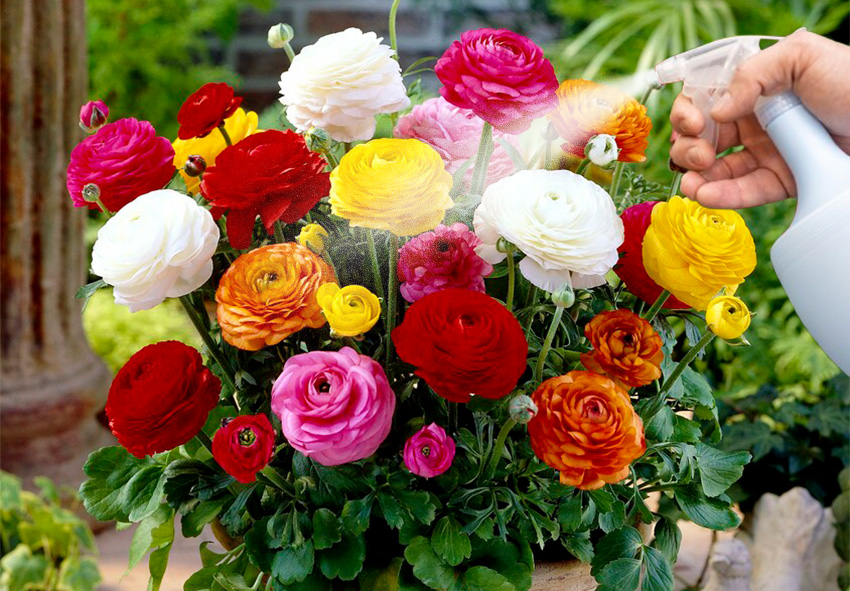
Ranunculus Asiaticus (Persian buttercup) is a stunning flower, but like any plant, it can face challenges that affect its growth and blooming potential. If your Ranunculus isn’t thriving, common issues such as lack of blooms, yellowing leaves, or rotting tubers may be the cause. Understanding these problems and their solutions can help you maintain a healthy and vibrant plant.
Failure to bloom is often due to excessive heat, poor soil conditions, or overcrowding. Ensuring cooler temperatures, nutrient-rich soil, and proper spacing will encourage flowering. Yellowing leaves or weak growth typically result from overwatering or nutrient deficiencies. Adjusting watering habits and feeding your plants with a balanced fertilizer can restore their vigor. Additionally, tuber rot is a frequent problem caused by overly wet soil or lack of air circulation. Planting in well-draining soil and spacing tubers correctly can prevent this issue.
By identifying these problems early and applying the right solutions, you can keep your Ranunculus Asiaticus (Persian buttercup) healthy and flourishing throughout the season.
Troubleshooting Guide
To maintain healthy Ranunculus Asiaticus, it’s important to recognize and address common issues early. If your plants aren’t blooming, they may need better soil and cooler temperatures. Yellowing leaves often indicate watering or nutrient problems, while rotting tubers signal poor drainage. Proper care and growing conditions will ensure beautiful, long-lasting blooms.
Issue 1: Ranunculus Not Blooming (100-word intro)
A thriving Ranunculus Asiaticus (Persian buttercup) should produce lush, vibrant blooms, but sometimes plants fail to flower. This issue can be frustrating for gardeners, especially when the plants appear otherwise healthy. The lack of blooms is often linked to environmental conditions, improper soil, or overcrowding. Identifying and addressing these factors can encourage proper flowering and ensure your plants reach their full potential. Understanding the causes and implementing the right solutions will help your Ranunculus bloom abundantly throughout the season.
Causes of Ranunculus Not Blooming:
- Excessive heat – High temperatures can cause stress and prevent flower formation.
- Poor soil conditions – Nutrient-deficient or compacted soil hinders healthy growth.
- Overcrowding – Tubers planted too close compete for nutrients, reducing flowering potential.
Solutions to Encourage Blooming:
- Plant in cooler conditions – Ranunculus thrives in temperatures between 50-65°F (10-18°C).
- Improve soil quality – Use fertile, well-draining soil enriched with compost.
- Space tubers properly – Plant 4-6 inches apart to prevent overcrowding.
Issue 2: Yellowing Leaves or Weak Growth (100-word intro)
If your Ranunculus Asiaticus (Persian buttercup) develops yellow leaves or weak stems, it may indicate an underlying issue affecting plant health. These symptoms are commonly caused by overwatering or nutrient deficiencies, both of which can weaken the plant’s ability to produce strong foliage and flowers. Ensuring proper watering habits and providing the right nutrients can help revive struggling Ranunculus plants and promote vigorous growth. Recognizing the signs early and making necessary adjustments will prevent further decline and keep your plants looking lush and vibrant.
Causes of Yellowing Leaves or Weak Growth:
- Overwatering – Excess moisture leads to root suffocation and weak stems.
- Nutrient deficiency – Lack of essential nutrients results in poor growth.
Solutions to Strengthen Growth:
- Improve drainage – Ensure soil drains well to prevent excess water retention.
- Water correctly – Allow the top inch of soil to dry before watering again.
- Use a balanced fertilizer – Apply a 10-10-10 or similar fertilizer every two weeks.
Issue 3: Ranunculus Tubers Rotting (100-word intro)
Rotting tubers are a common issue that can prevent Ranunculus Asiaticus (Persian buttercup) from growing properly. Since Ranunculus tubers are highly sensitive to excessive moisture, improper soil conditions or poor air circulation can cause them to decay before they even sprout. Preventing rot starts with selecting the right planting conditions, as well as ensuring that excess water drains away effectively. By planting tubers correctly and monitoring soil moisture levels, you can reduce the risk of rot and improve plant survival rates.
Causes of Ranunculus Tubers Rotting:
- Soil too wet – Waterlogged soil suffocates tubers and promotes fungal growth.
- Poor air circulation – Lack of spacing encourages humidity and rot.
Solutions to Prevent Tuber Rot:
- Use well-draining soil – Mix sand or organic matter to improve aeration.
- Space tubers properly – Keep 4-6 inches apart to reduce humidity buildup.
- Water sparingly – Keep soil slightly moist but not soggy to avoid rot. on. Proper soil and spacing will help keep Ranunculus tubers healthy.
Propagating Ranunculus Asiaticus: Growing More Beautiful Blooms
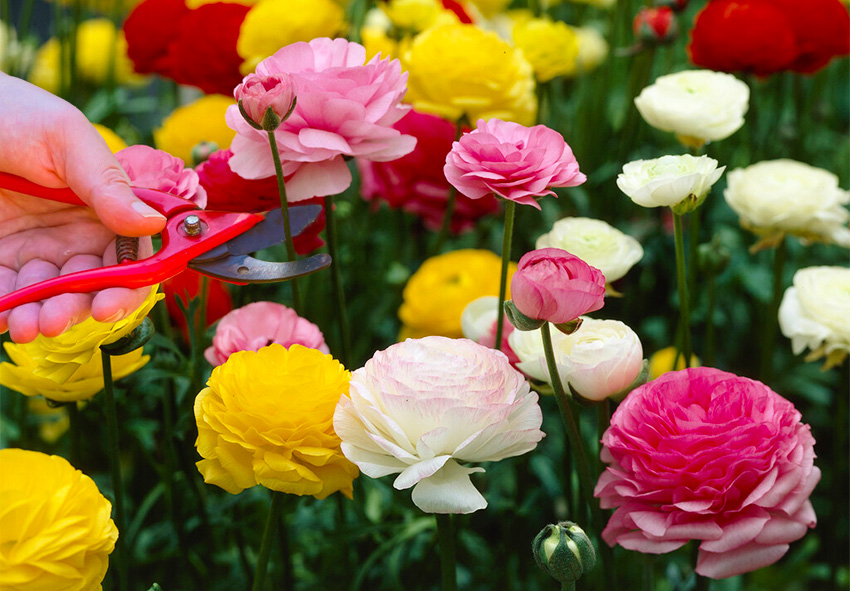
Ranunculus Asiaticus (Persian buttercup) is a stunning addition to any garden, and propagating these vibrant flowers allows you to expand your collection and enjoy even more of their delicate, multi-layered blooms. There are two primary methods for propagating Ranunculus: dividing tubers and growing from seeds. Dividing tubers is the most efficient and reliable method, as it ensures new plants will closely resemble the parent plant. This technique allows for faster blooming, with flowers appearing in the next growing season.
Growing Ranunculus from seeds is another option, though it requires more patience. While seeds can be collected and sown to produce new plants, this method often results in variations in flower color and shape. Additionally, Ranunculus grown from seed take longer to reach maturity, typically requiring one to two years before they begin blooming. Whether you choose to divide tubers or start from seeds, proper care and planting techniques will ensure healthy new growth and a thriving garden filled with these beautiful flowers.
How to Propagate Ranunculus Asiaticus (Persian buttercup) Step-by-Step
Propagating Ranunculus Asiaticus (Persian buttercup) can be done through tuber division or seed planting. Dividing tubers is the quickest and most effective method, while growing from seeds requires patience but allows for genetic diversity. Both methods require careful preparation and proper growing conditions to ensure healthy plants and vibrant blooms in the future.
Step 1: Dividing Tubers for Propagation
Dividing tubers is the most reliable way to propagate Ranunculus Asiaticus (Persian buttercup) and maintain the characteristics of the parent plant. This process should be done in late summer or early fall, once the plant has finished blooming and the foliage has withered. At this stage, the tubers enter dormancy, making it the ideal time to dig them up without causing damage. Carefully remove the tubers from the soil and gently shake off any excess dirt to inspect their condition.
Look for healthy, firm tubers with multiple offsets, which are small tuberous growths attached to the main tuber. Using clean, sharp garden shears, separate the offsets from the parent tuber, ensuring each piece has at least one growing point. Store the divided tubers in a cool, dry place over winter and replant them in early spring for a new season of blooms.
Step 2: Growing Ranunculus Asiaticus (Persian buttercup) from Seeds
Growing Ranunculus Asiaticus (Persian buttercup) from seeds is a rewarding but slower propagation method that requires careful attention to temperature and soil conditions. Since Ranunculus prefers cool weather, seeds should be sown in late summer or early fall in regions with mild winters. In colder climates, they can be started indoors in trays before being transplanted outdoors in early spring.
For successful germination, seeds need well-draining soil and temperatures between 50-60°F (10-15°C). Lightly press the seeds into the soil without covering them completely, as they require light to germinate. Keep the soil consistently moist but not waterlogged, and provide indirect light. Germination can take several weeks, and seedlings must be carefully nurtured before transplanting. It can take one to two years before seed-grown Ranunculus flowers, but the wait is worthwhile as the plants develop strong root systems and produce an array of unique blooms.
Frequently Asked Questions (FAQs) about Ranunculus Asiaticus
1. How often should I water Ranunculus asiaticus?
Water regularly during active growth and flowering, keeping the soil consistently moist but never waterlogged. Overwatering can cause tuber rot. Allow the top inch of soil to dry out slightly between waterings. Reduce watering once the foliage begins to yellow, as the plant is entering dormancy. Proper watering helps support strong blooms and healthy tubers for future growth. Always ensure the container or garden bed has excellent drainage.
2. Can I order Holland Ranunculus asiaticus from your online store?
Yes, in our online store Dutch-bulbs.com we offer a wide selection of Ranunculus asiaticus, including some varieties originating from Holland, renowned for their quality and beauty. Explore our collection to find the perfect Ranunculus asiaticus varieties for your garden or landscaping projects.
3. How do I store Ranunculus asiaticus tubers after flowering?
Once the foliage has died back in late spring or early summer, gently dig up the tubers. Allow them to dry in a shaded, airy place for several days. Clean off excess soil and store the tubers in a cool, dry, and dark area (around 50°F) in paper bags or peat moss. Proper storage prevents rot and ensures the tubers are healthy and ready to replant in the fall or late winter.
4. Why isn’t my Ranunculus blooming?
Ranunculus asiaticus may fail to bloom due to poor lighting, overcrowding, or improper temperature. Ensure they receive full sun (6+ hours daily) and are planted in cool weather, as high heat can stunt blooms. Tubers planted too deeply or in soggy soil may also fail to thrive. Provide balanced fertilizer during growth and avoid high nitrogen levels. Check that the tubers are healthy and not old or dried out before planting.
5. Can Ranunculus asiaticus be grown indoors?
Yes, Ranunculus asiaticus can thrive indoors with the right conditions. Place the container near a bright window where it receives 6–8 hours of sunlight daily. Use well-draining potting mix and a pot with drainage holes. Keep the soil evenly moist but not soggy. Indoor plants appreciate cool temperatures (50–65°F). Once flowering ends, let the foliage die back naturally, then lift and store the tubers if you want to regrow them next season.
Published: 04.04.2025
